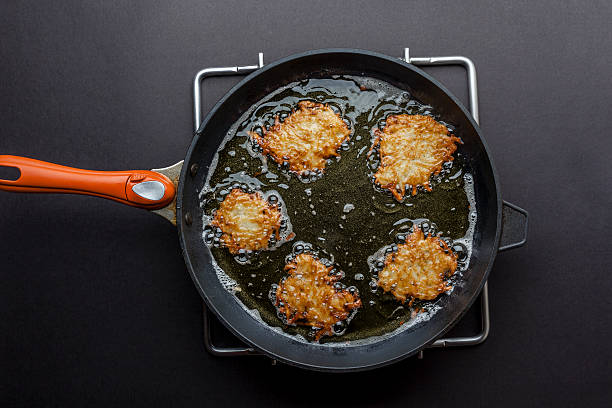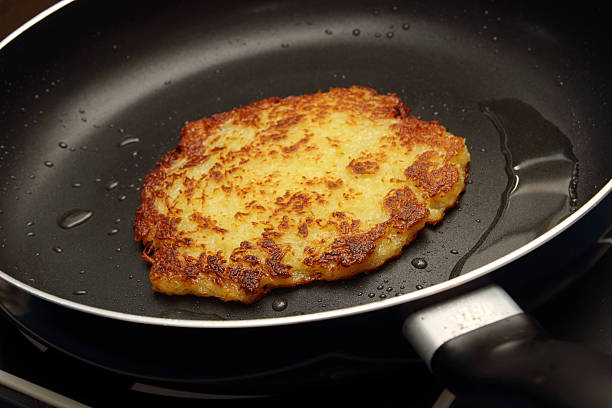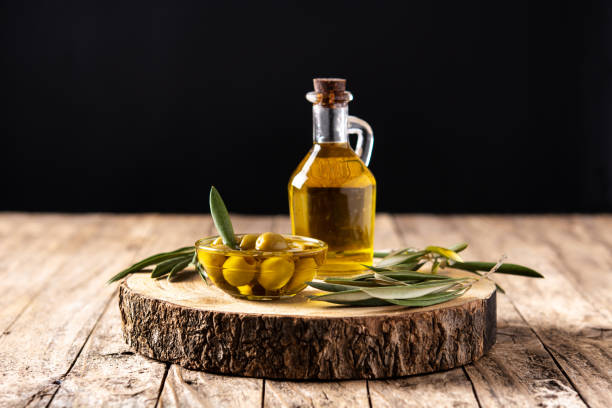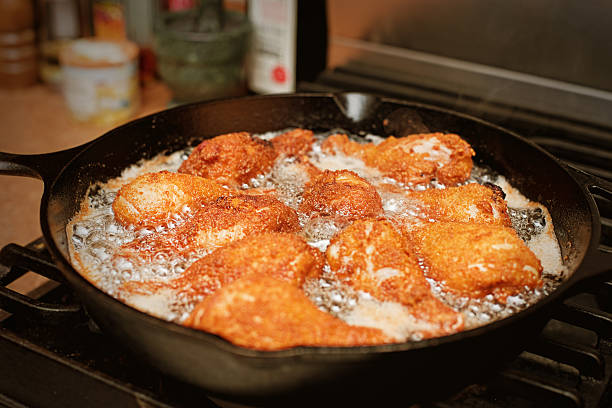In a world where culinary debates sizzle hotter than a searing skillet, the question of whether pan frying reigns as a virtuous culinary technique or a nutritional nemesis is a hot topic on every foodie’s mind.
Picture this: the tantalizing aroma of sizzling ingredients dancing in a glistening pan, promising a symphony of flavors and textures.
But beneath the surface, lurks a conundrum – does this method of cooking lead down the path of indulgence or does it offer a gateway to guilt-free gastronomy?
Let’s embark on a culinary odyssey to uncover the sizzle behind the science, exploring the nuances of pan frying to unveil whether it’s a halo-wearing hero or a stealthy villain in the realm of healthy eating.

Is Pan Frying Healthy
Pan frying can be part of a healthy diet when done in moderation and with the right techniques. However, excessive use of oil and high cooking temperatures can lead to the formation of harmful compounds, making it less healthy compared to other cooking methods.
Pan frying, a popular cooking method, involves cooking food in a small amount of oil over moderate to high heat. It’s beloved for its ability to create deliciously crispy textures and flavors in various foods.
The Health Impact of Pan Frying
While pan frying can enhance the taste and texture of dishes, it’s crucial to consider its health implications. The use of oil and high temperatures can lead to the formation of harmful compounds such as advanced glycation end products (AGEs) and polycyclic aromatic hydrocarbons (PAHs), which are associated with various health risks, including inflammation and cancer.
Factors Influencing Healthiness
The healthiness of pan frying depends on several factors, including the type of oil used, cooking temperature, and duration. Opting for healthier oils like olive oil or avocado oil and avoiding overheating can mitigate the formation of harmful compounds, making pan frying a healthier cooking option.
Balanced Approach to Pan Frying
To enjoy the benefits of pan frying while minimizing health risks, it’s essential to adopt a balanced approach. This includes using minimal oil, choosing healthier cooking oils, and incorporating plenty of vegetables and lean proteins into pan-fried dishes. Moreover, pairing pan-fried foods with whole grains and salads can create a more nutritious meal.
Understanding Pan Frying
Pan frying, often hailed as a fundamental cooking technique, entails the process of cooking food in a shallow pan with a small amount of oil or fat over medium to high heat.
To truly master this culinary art, it’s imperative to grasp the essence of heat control, ensuring your ingredients are evenly cooked to golden perfection.
Achieving that coveted crispiness while preserving moisture within the food requires finesse and attentiveness throughout the cooking process.
Understanding the nuances of pan frying involves recognizing the importance of selecting the right pan and oil combination, as well as understanding the optimal cooking times for various ingredients.
From tender meats to delicate vegetables, each component demands a tailored approach to achieve the desired texture and flavor profile.
Whether you’re searing succulent steaks, sautéing vibrant veggies, or indulging in the crispy goodness of fried delights, mastering the technique of pan frying opens doors to a world of culinary possibilities.
With dedication and practice, you’ll soon find yourself wielding the spatula with confidence, delighting in the sizzle and aroma of perfectly executed dishes that captivate the senses and satisfy the soul.
Nutritional Impact of Pan Frying
Pan frying, a popular cooking method, can have varying effects on the nutritional composition of foods. While it adds flavor and texture, it also involves the use of oil or fat, which can contribute additional calories and fat content to the dish.
However, the extent of these changes depends on factors such as the type and amount of oil used, cooking temperature, and duration.
When foods are pan fried, they may absorb some of the cooking oil, increasing their fat content. This can be managed by using healthier oils like olive or avocado oil and minimizing the amount used.
The high heat of pan frying can lead to the breakdown of certain nutrients, such as vitamins and antioxidants, although the degree of loss varies depending on the food and cooking time.
Despite these considerations, pan frying can also be a nutritious cooking method when done mindfully. By incorporating lean proteins, whole grains, and plenty of vegetables into pan-fried dishes, you can create balanced meals that provide essential nutrients while still satisfying your taste buds.
Pairing pan frying with techniques like steaming or baking can further enhance the nutritional profile of your meals.
Health Benefits of Pan Frying

While pan frying is often associated with adding fats to foods, it can offer some health benefits when done correctly and in moderation.
Firstly, pan frying allows for the retention of nutrients and flavors in foods, as it cooks them quickly over high heat, preserving their natural goodness. This method can also promote the consumption of nutrient-rich foods like vegetables and lean proteins, as they can be cooked quickly with minimal added fats.
Moreover, using healthy cooking oils like olive oil or avocado oil for pan frying can provide essential fatty acids and antioxidants that are beneficial for heart health. These oils are rich in monounsaturated fats, which can help improve cholesterol levels and reduce the risk of heart disease when consumed as part of a balanced diet.
Pan frying can promote portion control, as it requires less oil compared to deep frying methods. By using a minimal amount of oil and cooking smaller portions, you can reduce overall calorie intake while still enjoying delicious, flavorful meals.
Furthermore, pan frying can be a convenient cooking method, making it easier to prepare homemade meals instead of relying on processed or takeout foods, which are often higher in unhealthy fats and sodium.
Overall, when practiced mindfully and combined with healthy ingredients, pan frying can be a part of a nutritious diet that supports overall health and wellbeing.
Health Risks Associated with Pan Frying
While pan frying can produce tasty and satisfying dishes, there are potential health risks associated with this cooking method. One significant concern is the formation of harmful compounds when cooking at high temperatures with certain oils.
When oils reach their smoke point, they can break down and release compounds such as aldehydes and acrylamide, which have been linked to adverse health effects including inflammation and increased cancer risk.
Additionally, pan frying often involves the use of added fats and oils, which can contribute to excess calorie intake and weight gain if consumed in large amounts. Foods cooked through pan frying may absorb some of the oil, increasing their calorie content and potentially contributing to unhealthy lipid profiles when consumed frequently.
Furthermore, cooking foods at high temperatures for extended periods can lead to the formation of advanced glycation end products (AGEs), which are compounds formed when sugars react with proteins or fats.
Diets high in AGEs have been associated with inflammation, insulin resistance, and an increased risk of chronic diseases such as diabetes and cardiovascular disease.
Another concern is the potential for nutrient loss during the pan frying process, particularly water-soluble vitamins like vitamin C and B vitamins, which can be sensitive to heat and leach out into cooking liquids.
To mitigate these health risks, it’s essential to practice moderation when pan frying and choose healthier cooking oils with high smoke points, such as olive oil or avocado oil.
Incorporating plenty of fruits, vegetables, and whole grains into the diet can help counterbalance any potential negative effects of pan-fried foods.
Finally, varying cooking methods and incorporating techniques like baking, steaming, or grilling can further reduce exposure to harmful compounds while still enjoying delicious and nutritious meals.
Strategies for Healthier Pan Frying
Strategies for healthier pan frying encompass a combination of smart ingredient choices and cooking techniques aimed at minimizing the formation of harmful compounds while maximizing flavor and nutrition. Here are some key approaches:

A. Selection of healthier cooking oils with higher smoke points
Selecting healthier cooking oils with higher smoke points is crucial for safer and more nutritious pan frying. Oils with high smoke points are less likely to break down and produce harmful compounds when exposed to high temperatures.
Opting for oils such as avocado oil, which has a smoke point of around 520°F (270°C), or refined coconut oil with a smoke point of approximately 450°F (232°C), can provide stability during cooking while imparting a pleasant flavor to dishes.
Additionally, oils like peanut oil, safflower oil, and refined olive oil are also suitable choices for pan frying due to their high smoke points.
These oils offer a healthier alternative to oils with lower smoke points, such as butter or extra virgin olive oil, which are better suited for low to medium heat cooking methods to preserve their delicate flavors and nutritional benefits.
By selecting oils with higher smoke points, you can ensure safer and more nutritious pan frying while achieving delicious results.
B. Moderation in oil usage and portion sizes
Moderation in oil usage and portion sizes is essential for healthier pan frying practices. While oil is necessary for achieving the desired texture and flavor in pan-fried dishes, excessive use can lead to unnecessary calorie intake and potential health risks. To promote moderation:
- Use Oil Sparingly: Instead of pouring oil directly into the pan, consider using a spray bottle or brush to lightly coat the cooking surface. This helps control the amount of oil used and prevents excess absorption by the food.
- Portion Control: Be mindful of portion sizes when pan frying. Avoid overcrowding the pan, as this can lead to uneven cooking and the need for more oil. Cook in batches if necessary to ensure each piece of food has ample space to brown evenly.
- Consider Alternative Cooking Methods: Explore alternative cooking techniques that require less oil, such as stir-frying with broth or water, or using non-stick pans that require minimal oil for cooking.
- Monitor Oil Absorption: Some foods, especially porous ones like eggplant or tofu, tend to absorb more oil during frying. Pre-treating these foods by lightly salting and draining them can help reduce oil absorption and promote healthier frying.
- Choose Healthier Oils: Opt for oils with healthier fat profiles, such as those high in monounsaturated or polyunsaturated fats, and lower in saturated fats. Examples include olive oil, avocado oil, or canola oil. These oils provide flavor and texture while offering beneficial nutrients.
By practicing moderation in oil usage and portion sizes, you can enjoy the benefits of pan frying while maintaining a healthier diet and reducing the risk of excess calorie intake.
C. Incorporation of protective measures to reduce harmful compound formation
Incorporating protective measures to reduce harmful compound formation during pan frying is essential for promoting healthier cooking practices. Here are several strategies to consider:
- Marinating: Marinating foods before pan frying can help reduce the formation of harmful compounds. Using acidic ingredients like lemon juice, vinegar, or yogurt in marinades can inhibit the formation of carcinogenic compounds like heterocyclic amines (HCAs) and polycyclic aromatic hydrocarbons (PAHs) during cooking.
- Use of Antioxidants: Adding antioxidant-rich ingredients to dishes can help mitigate oxidative damage caused by high-heat cooking. Incorporate herbs, spices, garlic, onions, and colorful vegetables like bell peppers and tomatoes into your recipes. These ingredients contain antioxidants that can neutralize free radicals formed during cooking.
- Avoid Overcooking: Monitor cooking times and temperatures closely to prevent overcooking or charring of foods, which can increase the formation of harmful compounds. Use a food thermometer to ensure that meats are cooked to the proper internal temperature without excessive browning.
- Flip or Stir Foods: Flip or stir foods regularly during pan frying to promote even cooking and prevent burning. This helps distribute heat more evenly and reduces the likelihood of forming charred or crispy areas on the surface of the food.
- Choose Cooking Methods Wisely: Consider alternative cooking methods that produce fewer harmful compounds, such as steaming, boiling, or baking. These methods expose foods to lower temperatures and less direct heat, reducing the risk of harmful compound formation.
By incorporating these protective measures into your pan frying routine, you can minimize the formation of harmful compounds while still enjoying delicious and nutritious meals.
Practical Tips and Alternatives
Certainly! Here are some practical tips and alternatives for healthier pan frying:
Preheat the Pan
Preheating the pan is a fundamental step in achieving successful and flavorful cooking results. By preheating the pan before adding ingredients, you create an optimal cooking environment that promotes even heat distribution and minimizes the risk of food sticking to the surface.
This process ensures that the pan reaches the desired temperature before cooking begins, allowing ingredients to sear and caramelize effectively.
Preheating also helps to activate the Maillard reaction, a chemical process responsible for developing complex flavors and enhancing the taste of food.
Whether you’re pan frying vegetables, meats, or seafood, taking the time to preheat the pan properly sets the stage for a delicious culinary experience, resulting in perfectly cooked dishes with exceptional flavor and texture.
Use Non-Stick Cookware
Using non-stick cookware is a practical and convenient approach to healthier cooking. Non-stick pans are designed with a special coating that prevents food from sticking to the surface, reducing the need for excessive oil or fats during cooking.
This feature not only helps to lower calorie intake but also promotes easier cleanup. By utilizing non-stick cookware, you can minimize the risk of overcooking or burning food, as ingredients slide effortlessly across the pan without sticking.
Non-stick cookware is available in various sizes and styles, making it versatile for a wide range of cooking tasks, from sautéing vegetables to frying eggs. Whether you’re striving to reduce fat intake or simplify your cooking routine, incorporating non-stick cookware into your kitchen arsenal can contribute to healthier and more enjoyable meals.
Opt for Healthy Oils
Opting for healthy oils is a crucial aspect of maintaining a nutritious diet while cooking. Certain oils offer a range of health benefits due to their unique fatty acid composition and nutrient profiles.
For pan frying, selecting oils with high smoke points is essential to prevent the formation of harmful compounds at high temperatures. Olive oil, particularly extra virgin olive oil, is a popular choice for its rich flavor and abundance of heart-healthy monounsaturated fats.
Avocado oil, with its high smoke point and mild flavor, is another excellent option for pan frying. Oils like grapeseed oil, almond oil, and coconut oil are suitable choices due to their high smoke points and nutritional properties.
When choosing oils, consider factors such as taste preferences, cooking temperatures, and health benefits. By opting for healthy oils in your cooking endeavors, you can enhance the flavor of your dishes while promoting overall well-being and reducing the risk of chronic diseases.

Measure Oil Carefully
Measuring oil carefully is a simple yet effective strategy for promoting healthier cooking habits. By accurately measuring the amount of oil used in pan frying, you can control portion sizes and reduce unnecessary calorie intake.
Excess oil can lead to a higher calorie content in dishes without necessarily adding significant flavor or texture. Using measuring spoons, kitchen scales, or oil sprayers can help ensure precise measurements and prevent overpouring.
Measuring oil carefully allows you to monitor and adjust the amount of fat used in recipes, helping you achieve your dietary goals without sacrificing taste. Whether you’re sautéing vegetables or searing meats, taking the time to measure oil carefully contributes to more balanced and nutritious cooking practices.
Cook at the Right Temperature
Cooking at the right temperature is a critical factor in achieving successful pan frying and ensuring food safety and optimal flavor. Different foods require different cooking temperatures to cook properly and avoid burning or undercooking.
For pan frying, it’s generally recommended to cook over moderate to medium-high heat to achieve a golden brown crust without burning the exterior.
Heating the pan too high can lead to smoking and the formation of harmful compounds, while cooking at too low a temperature may result in soggy or greasy food.
Using a kitchen thermometer or observing visual cues such as shimmering oil or gentle sizzling can help determine when the pan is at the right temperature for cooking.
By maintaining the correct cooking temperature, you can achieve beautifully cooked dishes with delicious flavor and texture while minimizing the risk of foodborne illnesses or burnt flavors.
Blot Excess Oil
Blotting excess oil is a simple yet effective technique to reduce the overall fat content of pan-fried dishes while maintaining their flavor and texture. After cooking, especially when using oil-rich ingredients or generous amounts of oil in the pan, place the cooked food on a plate lined with paper towels.
Gently press another paper towel on top of the food to absorb any excess oil on the surface. This process helps remove visible oil without compromising the dish’s taste or moisture.
By blotting excess oil, you can enjoy lighter and healthier versions of your favorite pan-fried foods, ensuring a satisfying meal without unnecessary added fats.
Try Dry Pan Frying
Dry pan frying, also known as dry sautéing, is a technique that involves cooking food in a dry pan without the addition of oil or fat. This method is particularly suitable for foods that naturally contain fats or release moisture during cooking, such as meats, mushrooms, and certain vegetables.
To dry pan fry, start by preheating a non-stick skillet or frying pan over medium-high heat until hot. Then, add the food directly to the dry pan and cook, stirring or flipping occasionally, until the food is cooked through and has developed a golden brown crust.
The natural fats and moisture released from the food help prevent sticking and promote browning without the need for added oil.
Dry pan frying is a healthier alternative to traditional pan frying as it reduces calorie intake and fat content while still delivering deliciously flavorful results. It’s a versatile cooking technique that can be used for a variety of dishes, from searing steaks to sautéing vegetables, offering a convenient and nutritious cooking option for health-conscious individuals.

Experiment with Broiling
Experimenting with broiling is an excellent way to achieve flavorful and nutritious dishes with minimal added fats. Broiling is a cooking method that exposes food to high heat from above, similar to grilling but without the need for an outdoor grill.
To broil food, preheat the broiler in your oven and place the food on a broiler pan or a baking sheet lined with foil. Arrange the food in a single layer, ensuring that there is some space between each piece for even cooking.
Season the food as desired with herbs, spices, or marinades to enhance its flavor. Once the broiler is heated, place the food on the top rack of the oven, typically positioned 4-6 inches away from the heating element.
Keep a close eye on the food as it broils, as it can cook quickly and may require occasional turning or flipping for even browning. Broiling is a quick and efficient cooking method that produces deliciously charred and caramelized results without the need for added oils or fats.
It’s perfect for cooking a wide range of foods, including meats, fish, poultry, vegetables, and even fruits, offering a healthy and flavorful alternative to traditional pan frying.
Use Flavorful Ingredients
Using flavorful ingredients is key to creating delicious pan-fried dishes without relying heavily on added fats. Herbs, spices, aromatics, and other flavorful ingredients can enhance the taste of your dishes while reducing the need for excessive oil or butter.
Experimenting with a variety of herbs and spices allows you to create unique flavor profiles that elevate your cooking. Fresh herbs like basil, cilantro, and parsley add brightness and freshness to dishes, while spices such as cumin, paprika, and curry powder bring depth and complexity.
Aromatics like garlic, onions, and ginger provide a rich umami flavor that enhances the overall taste of your food. Additionally, incorporating flavorful ingredients like citrus zest, soy sauce, balsamic vinegar, and hot sauces can add a punch of flavor without extra calories.
By using flavorful ingredients creatively, you can create mouthwatering pan-fried dishes that are both healthy and satisfying, making every meal a culinary delight.
Explore Alternative Cooking Methods
Exploring alternative cooking methods is an excellent way to reduce the reliance on pan frying and incorporate healthier cooking techniques into your culinary repertoire. Here are several alternatives to consider:
- Baking: Baking involves cooking food in an oven using dry heat. It’s a versatile method suitable for a wide range of dishes, including meats, vegetables, casseroles, and baked goods. Baking requires little to no added fats, making it a healthier option compared to pan frying.
- Grilling: Grilling involves cooking food over an open flame or heat source. It imparts a delicious smoky flavor to foods without the need for added oils or fats. Grilling is a great option for lean proteins like chicken, fish, and vegetables.
- Steaming: Steaming involves cooking food by exposing it to steam from boiling water. It’s a gentle cooking method that helps retain nutrients and natural flavors without the need for added fats. Steaming is ideal for vegetables, seafood, and dumplings.
- Stir-Frying: Stir-frying involves cooking food quickly in a small amount of oil over high heat. It’s a popular cooking method in Asian cuisine that allows for quick cooking while preserving the natural colors and textures of ingredients.
- Roasting: Roasting involves cooking food in an oven at high temperatures, often with a small amount of oil or fat. It’s a versatile method suitable for meats, vegetables, and fruits, resulting in delicious caramelization and flavor development.
- Poaching: Poaching involves cooking food in gently simmering liquid, such as water, broth, or wine. It’s a low-fat cooking method that helps retain moisture and delicate flavors, making it ideal for delicate proteins like fish and eggs.
By exploring alternative cooking methods, you can expand your culinary skills, reduce the need for added fats, and create healthier and more nutritious meals for you and your family.
Cultural and Culinary Perspectives
From a cultural perspective, culinary traditions vary widely across different regions and cultures, influencing the cooking methods and ingredients used in everyday meals. In many cultures, pan frying is a popular cooking technique cherished for its ability to create flavorful and satisfying dishes.
For example, in Mediterranean cuisine, pan frying is often used to prepare dishes like sautéed vegetables, crispy fritters, and golden-brown fish fillets, showcasing the region’s abundance of fresh produce and seafood.
In Asian cuisine, stir-frying in a wok is a common cooking method that quickly cooks ingredients at high heat, resulting in vibrant and aromatic dishes such as stir-fried noodles, vegetables, and meats.
Culturally, the choice of oils and fats used in pan frying can also vary. In Mediterranean countries like Greece and Italy, extra virgin olive oil is a staple cooking fat, valued for its rich flavor and health benefits.
In Asian cultures, oils like sesame oil, peanut oil, and coconut oil are commonly used for stir-frying, each contributing its unique taste and aroma to dishes.
From a culinary perspective, pan frying offers versatility and flexibility, allowing cooks to experiment with different ingredients, flavors, and textures. It’s a technique that can be adapted to suit various dietary preferences and culinary traditions, whether it’s creating crispy fried chicken in the Southern United States, delicate tempura in Japan, or spicy chili paneer in India.
Overall, pan frying embodies the rich tapestry of cultural and culinary diversity, bringing people together through the shared experience of enjoying delicious and comforting meals prepared with care and creativity.
Debunking Myths and Misconceptions
Debunking myths and misconceptions surrounding pan frying is essential to understanding its role in a balanced diet and culinary practices. Here are a few common myths:
Myth: Pan frying is always unhealthy.
- Debunked: While excessive use of oil and frying at high temperatures can lead to unhealthy outcomes, pan frying can be part of a healthy diet when done in moderation and with healthier oils.
Myth: Pan frying destroys all nutrients in food.
- Debunked: While some water-soluble vitamins may be lost during cooking, pan frying can also help retain fat-soluble vitamins and enhance the absorption of certain nutrients, especially in foods cooked with healthy fats like olive oil.
Myth: Pan frying always leads to the formation of harmful compounds.
- Debunked: While cooking at very high temperatures with certain oils can lead to the formation of harmful compounds, choosing oils with higher smoke points and avoiding overheating can help minimize this risk.
Myth: All pan frying requires excessive amounts of oil.
- Debunked: Pan frying can be done with minimal oil or even without oil, using non-stick cookware, dry sautéing techniques, or alternative cooking methods like broiling or baking.
Myth: Pan frying is only suitable for unhealthy “junk” foods.
- Debunked: Pan frying can be used to prepare a wide variety of nutritious and delicious dishes, including vegetables, lean meats, seafood, and tofu, when done with the right ingredients and techniques.

Frequently Asked Questions (FAQs) – Is Pan Frying Healthy
Is pan frying a healthy cooking method?
Pan frying can be part of a balanced diet when done correctly. By using healthy oils in moderation and incorporating plenty of vegetables and lean proteins, you can create nutritious and delicious meals.
What are some tips for making pan frying healthier?
Opt for oils with high smoke points like olive oil or avocado oil, and use them sparingly. Additionally, choose lean cuts of meat and plenty of colorful vegetables to boost the nutritional value of your dishes.
Can pan frying help me incorporate more vegetables into my diet?
Absolutely! Pan frying is a great way to cook vegetables quickly while retaining their nutrients and flavor. Experiment with different seasoning and sauce combinations to make your veggies irresistible.
Is pan frying suitable for people with dietary restrictions?
Pan frying can accommodate various dietary needs. You can easily adjust recipes to be gluten-free, dairy-free, or vegetarian/vegan by choosing appropriate ingredients and seasonings.
How can I prevent my food from becoming greasy when pan frying?
To prevent greasiness, make sure your pan is properly heated before adding ingredients. Also, blot excess oil from cooked foods with paper towels, and consider using non-stick pans or cooking sprays to minimize the amount of oil needed.
Are there any health benefits to pan frying?
Pan frying allows you to cook food quickly at high temperatures, which can help retain more nutrients compared to slower cooking methods. Plus, the delicious flavors and textures achieved through pan frying can make healthy eating more enjoyable.
Can I still enjoy my favorite dishes through pan frying while maintaining a healthy lifestyle?
Absolutely! With some modifications, many classic dishes can be pan-fried in a healthier way. By focusing on quality ingredients and mindful cooking techniques, you can indulge in your favorites guilt-free.
Does pan frying require special culinary skills?
Not necessarily! Pan frying is a simple cooking technique that can be mastered with practice. With a bit of patience and attention to detail, anyone can become proficient at creating tasty and nutritious pan-fried meals.
Conclusion
In conclusion, while pan frying can impart delicious flavors and textures to food, its health implications depend heavily on various factors such as the type of oil used, cooking temperature, and frequency of consumption.
While moderation and mindful choices can mitigate some of the risks associated with pan frying, it’s important to recognize that excessive consumption of fried foods can contribute to health issues such as obesity, heart disease, and inflammation.
Incorporating alternative cooking methods like baking, grilling, or steaming, and opting for healthier oils rich in unsaturated fats can promote better overall health outcomes.
Ultimately, making informed decisions and balancing indulgence with nutritious choices is key to maintaining a healthy lifestyle.